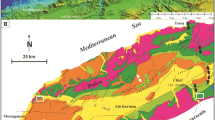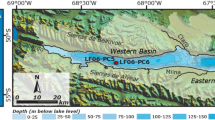Abstract
Frequently exchange of substance and energy in karst hyporheic zone may cause rapidly degeneration of groundwater environment. Hyporheic zone delineation and its nutrients exchange quantification are quite difficult in karst spring. To evaluate the source of organic matter (OM) and its environmental indication, 45 surface sediments were collected in a karst pool to determine the content of grain size, total organic carbon, total nitrogen, and stable isotope. C/N ratios showed that 83 % of OM is autochthonous source, but the contribution of OM carried by surface water backflow cannot be ignored. A high C/N ratios zone could be found in the tail of the pool. This is ascribed to surface river backflowing in extremely high water level. δ13C of OM ranged from −29.27 to −22.40 ‰, and they were consistent with isotope of local hydrophyte in the spring. Combined with elemental analysis, isotopic composition, grain size distribution and human activities, detailed water environmental function zones in the pool were defined; especially, the active hyporheic zone was determined. Our data reveal that the nature and distribution of OM are complex and dynamic in a karst hyporheic zone. Organic biogeochemistry may play more important role and drive the evolution of aquatic environment.








Similar content being viewed by others
References
Bao GD (1988) Geochemistry of organic carbon, nitrogen, phosphorus and silicon in surface sediment from Hangzhou Estuary and its adjacent continental shelf. J Oceanogr Taiwan Strait 7(4):366–375
Cahill RA (1981) Geochemistry of recent Lake Michigan Sediments. Illinois Institute of Natural Resources, State Geological Survey Division, Circular 517
Cormie AB, Schwarcz HP (1994) Stable isotopes of nitrogen and carbon of North American White-tailed deer and implications for paleodietary and other food web studies. Palaeogeogr Palaeoclimated Palaeoecol 107:227–241
Elizabeth AVM, Melanie JL, Jeremy ML, Carol A (2005) Bulk organic d13C and C/N ratios as palaeosalinity indicators within a Scottish isolation basin. J Quat Sci 20:303–312
Findlay S, Strayer D, Goumbala C, Gould K (1993) Metabolism of streamwater dissolved organic carbon in the shallow hyporheic zone. Limnol Oceanogr 38:1493–1499
Guo F, Jiang GH (2011) Karst groundwater management through science and education. Open J Geol 3:200–205
Guo F, Jiang GH, Polk JS, Huang XF, Huang SY (2015) Resilience of groundwater impacted by land use and climate change in a Karst aquifer, South China. Water Environ Res 87(11):1990–1998
Jiang GH, Guo F (2012) Source identification of Lingshui spring using GIS-Based hydrochemistry and environmental isotopic methods. Water Resour Prot 28(1):59–63
Keely JE, Sandquist DR (1992) Carbon: freshwater plants. Plant Cell Environ 15:1021–1035
Krishnamurthy RV, Bhattacharya SK, Kusumgar S (1986) Palaeoclimatic changes deduced from 13C/12C and C/N ratios of Karewa lake sediments, India. Nature 323:150
Kristensen E, Bouillon S, Dittmar T, Marchand C (2008) Organic carbon dynamics in mangrove ecosystems: a review. Aquat Bot 89:201–219
Lamb AL, Wilson GP, Leng MJ (2006) A review of coastal palaeoclimate and relative sea-level reconstructions using d13C and C/N ratios in organic material. Earth Sci Rev 75:29–57
López P, Tarazón JAL, Casas RJP, Pompeo M, Ordoñez J, Muñoz I (2016) Sediment size distribution and composition in a reservoir affected by severe water level fluctuations. Sci Total Environ 540:158–167
O’leary MH (1981) Carbon isotope fractionation in plants. Phytochemistry 20(4):553–567
O’leary MH (1988) Carbon isotopes in photosynthesis. Bioscience 38(5):328–336
Paoletti MG, Mattia B, Leandro DA, Alberto P (2011) A new foodweb based on microbes in calcitic caves: the Cansiliella (Beetles) case in Northern Italy. Int J Speleol 40(1):45–52
Pearson FJ, Coplen TB (1978) Stable isotope studies of lake. In: Lerman A (ed) Lakes: chemistry, geology, physics. Springer, New York, pp 235–236
Peng YJ, Xiao JL, Nakamura T, Liu B (2005) Holocene East Asian monsoonal precipitation pattern revealed by grain-size distribution of core sediments of Daihai Lake in Inner Mongolia of North-central China. Earth Planet Sci Lett 233:467–479
Qin J, Yang H, Zhang ML, Xie B, Li J, Sun PP, Wang YH (2015) Sources of organic matter in the sediments of Baoxiang river reservoir, Dianchi watershed. Geogr Res 34(1):53–64
Rosenfeld JK (1981) Nitrogen diagensis in Long Island Sound Sediments. Am J Sci 281(4):436–472
Schelske CL, Hodell DA (1991) Recent changes in productivity and climate of Lake Ontario detected by isotopic analysis of sediments. Limnol Oceanogr 36:961–975
Smith BN, Epstein S (1971) Two categories of 13C/12C ration for higher plants. Plant Physiol 47:380–384
Stein R (1991) Accumulation of organic carbon in marine sediments. Results from the Deep Sea Drilling Project/Ocean Drilling Program. Springer, Berlin
Stuiver M (1975) Climate versus changes in 13C content of the organic component of lake sediment s during the late Quaternary. Quatern Res 5:251–262
Wang HX, Xian WW (2011) Distribution of the total organic carbon of surface sediment and its influence factors in the Yangtze River Estuary. Mar Sci 35(5):24–31
Wang YJ, Liu DY, Richard P, Li X (2013) A geochemical record of environmental changes in sediments from Sishili bay, northern Yellow sea, China: anthropogenic influence on organic matter sources and composition over the last 100 years. Mar Pollut Bull 77(1/2):227–236
Wei ZQ, Liu ZQ, Liang XB, Wang FS, Wang SF (2005) Degradation and microbial action of organic matter in sediment of Hongfeng Lake, Guizhou. Sci Bull 50(14):1486–1489
Yin Y, Fang NQ, Hu CY, Nie HG, Qin ZL (2001) Palaeoenvironmental evolution deduced from organic carbon stable isotope compositions of Napahai Lake sediments, Northwestern Yunnan, China. J Lake Sci 13(4):289–295
Zhang EL, Ji Shen, Xia WL, Zhu YX, Wang SM (2002) Environmental records from organic carbon and its isotope of Qinghai Lake sediment. Mar Geol Quatern Geol 22(2):105–108
Acknowledgments
This study was supported through grants from Guangxi Natural Science Foundation (2013GXNSFDA019024), Chinese National Natural Science Foundation (41172231 and 41472239), and Chinese Academy of Geological Sciences (YYWF201504). We greatly appreciate the editor and two anonymous reviewers for their critical comments allowing improved interpretation of the data.
Author information
Authors and Affiliations
Corresponding author
Rights and permissions
About this article
Cite this article
Guo, F., Wang, W., Jiang, G. et al. Distribution and stable isotopic compositions of organic carbon in surface sediments in hyporheic zone of karst springs. Environ Earth Sci 75, 850 (2016). https://doi.org/10.1007/s12665-016-5672-8
Received:
Accepted:
Published:
DOI: https://doi.org/10.1007/s12665-016-5672-8




